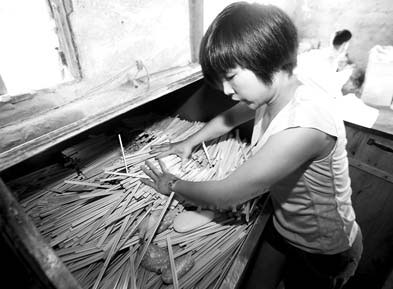Cheap chopsticks may be toxic, expert says
Updated: 2013-03-20 07:15
By Cheng Yingqi (China Daily)
|
||||||||
|
A worker at a chopstick factory shows how to polish disposable chopsticks with toxic paraffin wax and talc in Liuzhou, the Guangxi Zhuang autonomous region, in April. Zhang Cunli / Xinhua |
Sales of portable utensils surge online as health concerns rise
Chopsticks may bring to mind delicious Chinese dishes, hard-to-use tableware, or ravaged forests. However, the dinnerware now represents something far more sinister for Chinese Internet users: terrible toxins.
On Sunday, actor Huang Bo posted a message on his micro blog saying that when he tried to wash the disposable chopsticks provided to him in a restaurant, he was astonished to find that the chopsticks turned the water yellow and gave off a pungent smell.
"Stop using disposable chopsticks, it is not about saving the environment anymore, it is about saving your own life," Huang wrote on the micro blog.
The message was forwarded 125,000 times.
Angry netizens asked Huang to reveal the name of the restaurant, Huang said the bad chopsticks are not only provided in that one restaurant, but are widely distributed.
Dong Jinshi, secretary-general of the International Food Packaging Association, said the color and smell of the chopsticks may indicate that they were exposed to sulphur and other chemical substances.
"Sulphur, hydrogen peroxide, sodium sulfite and mold inhibitor, are chemical substances commonly used to make disposable chopsticks, even though they are not allowed," Dong said.
China enacted a national standard on disposable chopsticks in 2010. It included specific criteria on additional chemical agents and the amount allowable to produce chopsticks.
"For example, the standard says food-grade sulphur can be used in the production of bamboo chopsticks, while the sulfur dioxide residue should be controlled under 600 milligrams in one kilogram of chopsticks. But sulphur is not supposed to be used for wooden chopsticks," Dong said.
However, the standard has never been thoroughly carried out Dong told China Daily.
"There is not even a specific government department in charge of the quality control," he said.
According to Dong, most chopsticks are made in small workshops in mountainous regions, where the companies do not need a production license. The chopsticks are then shipped to large cities for packaging.
"For example, there are seven or eight chopstick plants in Daxing district, Beijing, all in charge of packaging. Because the chopsticks go through so many intermediate sellers, even the chopstick plant owners cannot specify the origin of their products," Dong said.
In 2010, Chinese media exposed the chaotic management of chopstick production. The State Food and Drug Administration published a notice asking local administrations to strengthen investigations into chopstick quality.
However, the result of that investigation was not posted on the website of the administration, and chopstick quality was never again listed as an important inspection item in the following years.
"The standard stayed theoretical. It had never been put into use in reality," Dong said.
Fan Zhihong, a food safety expert at China Agricultural University, said it is still difficult to make a risk assessment on disposable chopsticks.
"There is no data showing the amount of chemical residue or the amount of chemicals that can be transferred to people using them, and there are no reports of individuals being poisoned by the chopsticks, so it is difficult to determine their influence on human health," Fan said.
Nevertheless, consumers are not patient enough to find out whether disposable chopsticks are dangerous or not.
On popular online marketplace Taobao, portable chopsticks have become a big seller.
"Our business is generally good, but in the past two days, sales were really good," said a storeowner on Taobao, who sold 1,880 pairs of chopsticks in the past month.
"On the homepage of our store, I posted a lot of information telling people that disposable chopsticks are not good, but nobody cared in the past. So I guess movie stars like Huang Bo have a real influence on people," the storeowner said.
chengyingqi@chinadaily.com.cn
(China Daily 03/20/2013 page4)

 In Photos: 7.0-magnitude quake hits Sichuan
In Photos: 7.0-magnitude quake hits Sichuan
 Li Na on Time cover, makes influential 100 list
Li Na on Time cover, makes influential 100 list
 FBI releases photos of 2 Boston bombings suspects
FBI releases photos of 2 Boston bombings suspects
 World's wackiest hairstyles
World's wackiest hairstyles
 Sandstorms strike Northwest China
Sandstorms strike Northwest China
 Never-seen photos of Madonna on display
Never-seen photos of Madonna on display
 H7N9 outbreak linked to waterfowl migration
H7N9 outbreak linked to waterfowl migration
 Dozens feared dead in Texas plant blast
Dozens feared dead in Texas plant blast
Most Viewed
Editor's Picks

|

|

|

|

|

|
Today's Top News
Live report: 7.0-magnitude quake hits Sichuan, heavy casualties feared
Boston suspect cornered on boat
Cross-talk artist helps to spread the word
'Green' awareness levels drop in Beijing
Palace Museum spruces up
First couple on Time's list of most influential
H7N9 flu transmission studied
Trading channels 'need to broaden'
US Weekly

|

|








